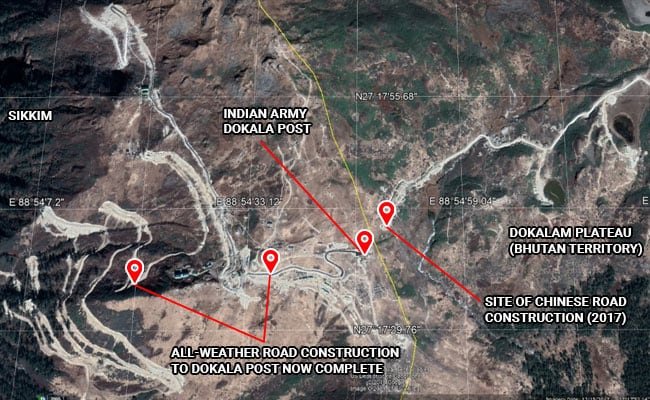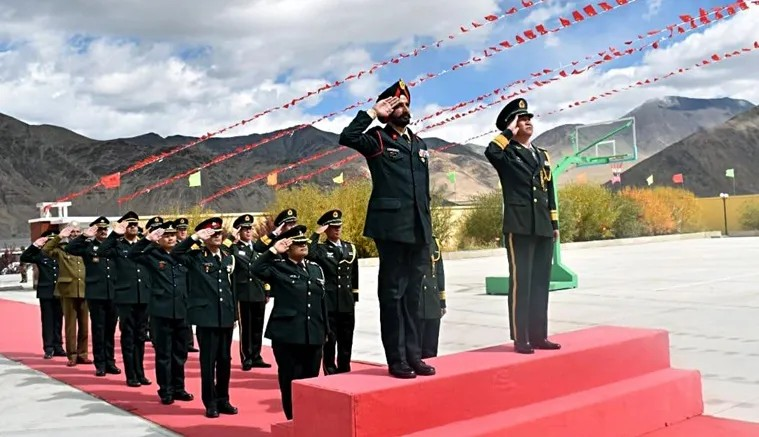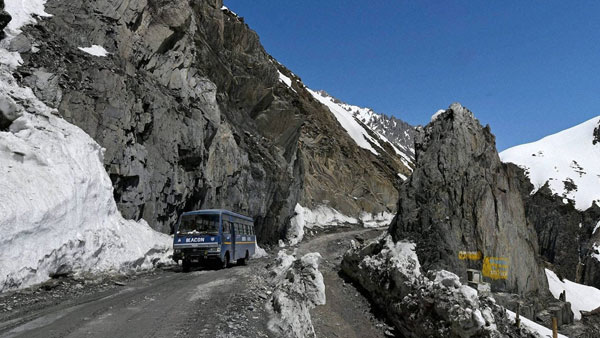Lt. Gen VG Khandare(r)

The Border Roads Organization (BRO) has played a pivotal role in enabling access to remote and challenging terrains, such as the rugged landscapes of Sikkim. The year 1980 marked the inception of my personal association with the BRO, where I witnessed the formidable challenges they faced in constructing and maintaining roads in the region.
Operating in Sikkim presented numerous obstacles, including narrow roads, frequent landslides, and adverse weather conditions. Despite limited plant equipment, the dedicated BRO team, comprising individuals from diverse backgrounds, persevered in their efforts, often relying on local labour to overcome these challenges. Their unwavering commitment to clearing the roads, even in harsh climates far from their homes, was truly commendable.
The treacherous road conditions necessitated a convoy system, with strict timing and limited traffic flow due to narrow stretches. This demanded patience and coordination, as vehicles had to wait for clearance before proceeding. The bridges, primarily of steel girder type, were susceptible to damage from heavy rains, requiring substantial time for repairs. Reflecting on the transformation from those arduous times to the present, it is evident that the BRO has made significant strides in enhancing infrastructure. The evolution of plant equipment, from antiquated machinery to modern technology, signifies a remarkable improvement. The dedication of the workforce, who once resorted to unconventional measures to keep equipment operational, is a testament to their resilience and commitment to their duty.

The journey from relying on a one-ton vehicle to now accommodating 2.5-ton vehicles and witnessing the development of gravel tracks into fully functional roads is a testament to the relentless efforts of the BRO. The progress made over the years, though gradual, has been instrumental in facilitating smoother and safer access to remote areas, as evidenced by my return to Dokala in 2017, a journey that once required several days of walking. The transformation of the infrastructure, from the challenges faced in 1980 to the improved accessibility in 2017, underscores the remarkable achievements of the BRO. Their unwavering dedication, adaptability, and perseverance have been pivotal in shaping the region’s connectivity and accessibility, making a lasting impact on the lives of those who rely on these vital routes.
The Border Roads Organisation (BRO) plays a crucial role in enhancing infrastructure development, particularly in border states where road connectivity is essential. As the government provides an impetus for road construction projects like the Golden Quadrilateral, the demand for equipment and labour surges, leading to competitive pricing and improved procurement processes for the BRO. However, challenges persist, especially regarding labour availability and sourcing. Border states have specific expectations for local labour engagement, but due to sparse populations and diverse occupations, unskilled labour from distant regions like Bihar and Jharkhand often fills the workforce gaps. The logistical complexities of transporting labour to work sites, coupled with environmental regulations and seasonal constraints, create significant pressures on the BRO.

Despite these challenges, the BRO has shown resilience and adaptability in overcoming obstacles. By leveraging contractors from regions like Dumka, Jharkhand, and Bihar, they ensure a steady supply of labour for road construction projects in remote areas. The dedication and hard work of these labourers, often overlooked at the lowest levels, form the backbone of the BRO’s operations.
The Border Roads Organization (BRO) relies heavily on the hard work and dedication of labourers from Bihar and Jharkhand. These individuals, often coming from poor backgrounds, are the backbone of the organization due to their tireless efforts. Even at the lowest level, their contributions are invaluable. It is not just the labourers who play a crucial role in BRO, but also the skilled plant operators, supervisors, and other civilian staff members who work tirelessly behind the scenes. The officering is a mix of both border road personnel and the Corps of Engineers from the army, showcasing the diverse talents and expertise within the organization.
Reflecting back on experiences in Ladakh in the late ’80s, I witnessed firsthand the importance of BRO’s work in maintaining road infrastructure in challenging terrains. From positioning detachments in strategic passes to keeping remote tracks open, the organization’s efforts are vital for ensuring connectivity in remote areas like Chushul.
Overall, the unsung heroes within BRO, including labourers from Bihar and Jharkhand, play a crucial role in the organization’s success. Their dedication and hard work are truly commendable, and they deserve recognition for their contributions to improving infrastructure and connectivity in difficult terrain. The Border Roads Organisation (BRO) is an indispensable force in the challenging terrains where their efforts are nothing short of heroic. Individuals who have experienced these areas firsthand often express profound admiration for the personnel from BRO. The symbiotic relationship between the army and the BRO is marked by mutual respect and unwavering support.
The BRO operates with meticulous organization, structured in platoons, companies, and task forces, seamlessly integrated at various levels. This intricate network ensures effective communication and collaboration with military commanders at different echelons. The Director General of Border Roads (DGBR) is constantly on the move, overseeing operations in remote locations such as Sela Pass, Rohtang Pass, and Zojila Pass, essential for efficient supervision and feedback mechanisms.
In the realm of technology, advancements such as geospatial imagery are anticipated to enhance monitoring and evaluation processes. Despite technological progress, the on-ground verification by personnel remains crucial. The dedication of BRO personnel is exemplified by historical instances, like the arduous journeys through Manipur in the 1990s, where they facilitated crucial movements along perilous single roads, mitigating risks and ensuring safe transit.
The arduous nature of their work is evident in the challenges faced, from time-consuming journeys to the constant threat of ambushes. However, the presence of BRO personnel not only ensures safe passage but also acts as a deterrent to potential threats, underscoring their vital role in safeguarding vital infrastructure and personnel in remote and hostile environments.
In conclusion, the Border Roads Organisation’s unwavering commitment and sacrifices in constructing and maintaining critical infrastructure in challenging terrains deserve immense respect and recognition. Their enduring partnership with the military and relentless dedication underscore their indispensable role in ensuring connectivity and security in remote regions.
BRO’s commitment to infrastructure development in challenging terrains is commendable, showcasing a blend of financial support, technological advancements, streamlined processes, and effective leadership at all levels. Despite facing multifaceted challenges, the BRO continues to persevere in its mission to enhance road connectivity in border regions, supported by the relentless efforts of labourers from various parts of the country.
Border Roads Organization (BRO): Pioneering Technological Marvels in Infrastructure Development
The Border Roads Organization (BRO) stands as a testament to unparalleled expertise in constructing bridges and tunnels, revolutionizing the landscape of transportation infrastructure. Over the years, BRO has honed its skills in bridge construction, evolving into a formidable force in the realm of tunnelling. Through strategic investments in training and international exposure, military officers have mastered the intricate art and science of tunnelling, propelling BRO to its current position of innovation and efficiency.
One of the key achievements of BRO lies in its ability to create tunnels that bypass extensive zigzag routes, effectively saving kilometers of travel. By eliminating the need for lengthy roads prone to landslides and maintenance challenges, these tunnels have streamlined connectivity and enhanced accessibility to remote regions. Moreover, in scenarios where traversing mountains or crossing rivers necessitates bridge construction, BRO has pioneered solutions to mitigate risks, such as the threat of enemy forces targeting bridges during wartime. The shift towards under-river bridging exemplifies BRO’s forward-thinking approach to infrastructure development, ensuring resilience and sustainability in the face of adversities.
A notable example of BRO’s transformative impact can be observed in the region of Pithoragarh, which has recently garnered attention due to border disputes with Nepal. The arduous journey from Bareilly to Tanakpur, onward to Pithoragarh, Tawa Ghat, Dhar Chula, and finally to Lipulekh, which once spanned three days, has been drastically reduced in recent years. Through innovative strategies like Heli-lifting heavy equipment to inaccessible terrains and constructing roads in challenging landscapes, BRO has significantly shortened travel durations and enhanced connectivity to remote border areas. This remarkable feat not only underscores BRO’s engineering prowess but also highlights the strategic importance of efficient infrastructure in bolstering national security and regional cooperation.
As neighbouring countries like Nepal express interest in leveraging BRO’s expertise, the organization’s commitment to non-exploitative cooperation stands out. Unlike geopolitical motives that drive some nations to seek alternative partnerships, BRO’s focus remains on fostering mutual development and connectivity with neighbouring countries like Bhutan, Nepal, Bangladesh, and Myanmar. The infrastructure marvels created by BRO not only attract admiration from countries with limited resources but also serve as a beacon of hope for inclusive and sustainable development in the region.

In a world where infrastructure plays a pivotal role in shaping geopolitical dynamics, BRO’s advancements in road and tunnel construction have not gone unnoticed by adversaries like China and Pakistan. The rapid expansion of road infrastructure by these nations underscores the strategic advantage of swift troop mobilization and logistical efficiency. However, BRO’s unwavering commitment to technological innovation and collaborative development sets a benchmark for responsible infrastructure growth, emphasizing the importance of inclusive progress over strategic dominance.
The Border Roads Organization stands at the forefront of technological innovation and infrastructure development, reshaping landscapes and fostering regional connectivity. Through its pioneering achievements in bridge construction, tunnelling, and road development, BRO exemplifies a commitment to excellence, efficiency, and sustainable progress. As nations across the region look to emulate BRO’s success, the organization’s legacy of transformative infrastructure development serves as a beacon of hope for a future built on cooperation, connectivity, and inclusive growth.
In the context of the 2008 situation in Sikkim, there was a stark contrast in the construction processes between the Indian and Chinese task forces in the Chumbi Valley. The efficiency and speed of the Chinese task force, equipped with modern machinery like dozers, JCBs, road rollers, and dumpers, were evident as they swiftly constructed roads, enabling quick access for tourists and others. In contrast, the Indian task force faced challenges with outdated equipment and limited manpower, resulting in delayed connectivity projects. The significance of infrastructure like roads, airfields, and helipads in border regions is crucial for mobilization and is often targeted in military conflicts. The labourers working on these projects, aware of the risks involved, show remarkable resilience in the face of adversities, including terrorist threats and attacks. Their dedication to their work, often driven by economic necessity, highlights their determination and the hardships they endure in maintaining essential infrastructure despite the dangers they face. The portrayal of such labourers as unsung heroes in border regions underlines their crucial role in ensuring connectivity and national security.
Galwan Standoff
In North Ladakh and East Ladakh, significant strides were made in infrastructure development, particularly in the construction of roads and bridges. Despite initial skepticism from within our own ranks, a determined effort was made to enhance connectivity in these areas, resulting in the establishment of vital road networks. This development proved crucial in facilitating the movement of tanks, vehicles, and artillery guns to the northernmost points, thereby strengthening our logistical capabilities around the clock. The strategic significance of these infrastructure improvements cannot be understated, especially in the context of potential conflict scenarios. The escalation of Chinese activity along the Line of Actual Control coincided with Xi Jinping assuming power in 2013 and the subsequent military transformation that followed. Xi’s emphasis on the “Chinese Dream” and ideas of national rejuvenation marked a shift towards a more assertive and aggressive stance, contributing to border standoffs and increased tensions. The distinction between the border guards and the PLA within the Chinese forces highlights differing approaches to border management, with the latter often being more inclined towards provocative actions. The construction of infrastructure in these sensitive border areas proved essential in maintaining territorial integrity and preventing scenarios similar to the Aksai Chin incident of 1959, underscoring the strategic necessity of road development in safeguarding our interests. Overall, the evolving dynamics along the border underscore the importance of strategic foresight and proactive measures in managing border disputes and ensuring national security.
Their deep-rooted sentiment of Indian troops when it comes to defending their territory. The protection of sovereignty is a matter of utmost importance, and any challenge to it is met with a strong response. This unwavering commitment to safeguarding the nation’s borders is deeply ingrained in the Indian psyche.
Indians have a strong attachment to their land, whether it be at a personal or national level. The concept of land ownership and the preservation of territorial integrity hold significant value in Indian culture. This sentiment extends beyond individual ownership to encompass the larger idea of national sovereignty.
When faced with a threat to their land or sovereignty, Indian troops are willing to put everything on the line, even their own lives. This dedication is a testament to the deep sense of duty and patriotism that drives these individuals to defend their land at all costs.
The relationship between India and its neighbours, particularly China, is complex and often fraught with tension. The ongoing border disputes serve as a reminder of the challenges that arise when two nations seek to assert their territorial claims. Despite these challenges, India remains resolute in its commitment to protecting its borders and preserving its sovereignty.
In conclusion, the recent confrontations along the LAC highlight the importance of sovereignty and territorial integrity to the Indian nation. The determination of Indian troops to defend their land reflects a broader cultural value placed on land ownership and national pride. As tensions continue to simmer along the border, it is crucial for both India and China to find diplomatic solutions to prevent further confrontations and ensure peace and stability in the region.
Lt. Gen. VG Khandare (r) PVSM, AVSM, SM is the Principal Adviser to the Ministry of Defence, India & Editorial Board Member of IADB.





